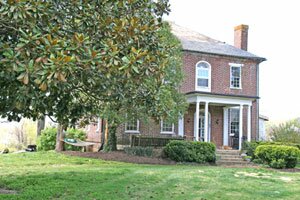REAL ESTATE- ON THE BLOCK- Castiglione: History, whimsy make a good pair

PHOTO COURTESY OF THE AGENT
ADDRESS: 6150 Faber Road
NEIGHBORHOOD: North Garden
ASKING: $850,000
ASSESSMENT: $380,700
YEAR BUILT: ca. 1809
SIZE: 3,040 fin. sq. ft., 760 unfin.
LAND: 17 acres
CURB APPEAL: 8 out of 10
LISTED BY: Tim Michel of McLean Faulconer Inc. 960-1124
Whenever we review a property that was originally a tavern (not counting Scottsville's Dew Drop Inn), we like to think back over the old taverns still in existence. Boswell's Tavern, Boyd Tavern, Michie Tavern, Lafayette Hill Tavern– that seems to be about it. Of those, only Michie Tavern is still up and running as a public house, and it's known more for its fried chicken and cottage cheese than for its yards of ale.
According to research by the current residents, Castiglione, just over the border in Albemarle from Nelson County, was originally a tavern/ "stagebridge" stop on the old road to Lynchburg, which is now just a grassy track in front of the house, disappearing into brush at John Grisham's Cove Creek baseball park to the south. And in his mighty survey of county properties, The Architecture of Jefferson Country, UV A architectural historian K. Edward Lay says that "tavern license receipts dating from 1830 to 1843" were found in the attic at Castiglione.
But its days as a public house ended early on, and it has been a private residence since. Just where the name comes from is not addressed in any of the historical literature the agent provides (or in Lay's book), but it's probably a safe guess that the same mania for Italian design that prompted Monticello to be so named in 1779 might have influenced either Alexander Blain or John T. Hamner– authorities differ about just who built Castiglione and when– some say Blain in 1809 and others say Hamner in the 1820s.
The house has the distinction of remaining virtually unchanged since its construction (with the exception of added kitchen and bathrooms, unknown at the time, of course), an unusual feat in houses this old. This can be a blessing or a curse for a new owner because the few adaptations do not appear to have been as felicitous as one might have hoped– which is a nice way of saying that the kitchen and the baths must all be completely re-done. The upside of authenticity is plaster walls, pine floors, and other woodwork unimaginable in even the most opulent new house today. The size and type of beams holding up the roof, for example, are probably unobtainable today except as salvage from places of this vintage.
The house consists of eight rooms, including a small "office" to the right of the front door, large (20' x 20') living and dining rooms, a large kitchen across the back of the house, four bedrooms (one 18' x 20') with a wide, ornate staircase connecting it all.
Outbuildings include a three-bedroom rental cottage, the original smokehouse, and a garage/workshop.
One interesting thing about the place which is not evident upon a quick inspection or even from the agent's literature, is the unusual care and creativity the current owner has lavished on the landscaping. And "unusual" might even be too mild a word.
From the house, a small pond is visible, surrounded this time of year by some pretty daylilies and other perennials. Away to the back one can see some odd constructions: big timbers that might be the beginning of a pergola or trellis. But walking a little distance from the house brings visitors to formal brick pillars forming the entrance to what looks like a big thicket of privet hedge with some strange treehouse-like edifice towering over the middle.
And that's exactly what it is– well, almost exactly. Turns out the privet thicket is in fact a very elaborate (and very tall) maze which, even without Theseus's ball of thread, can be navigated– with some care. And it turns out the various twists and crannies of the maze spell "Castiglione." (However, this triumph of design is only visible to aircraft!).
Just what prompted the owner to pursue such a project is unclear– the tree house and a second large shallow fish pond are part of the plan, apparently– but there's no doubt it's one of the most unusual elements we've encountered on our travels.
History and whimsy are rarely so closely intertwined. We predict Castiglione will appeal to a buyer as unusual as the property itself– someone with a love for tradition and authenticity, but with an eye for merriment and fun. If the rescue of the old place is undertaken by a person who fits that profile, it's probably safe to say that its future will look as bright and sunny as the views of surrounding fields and mountains from the pretty front porch on the day we visited, alas, without a yard of ale to quench our thirst.


Photos courtesy of the agent
#